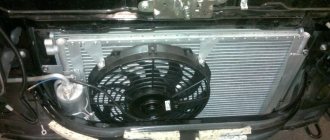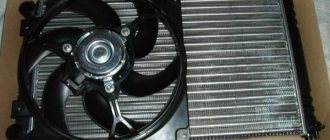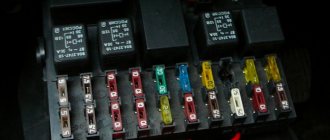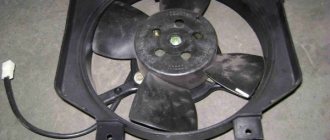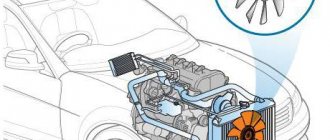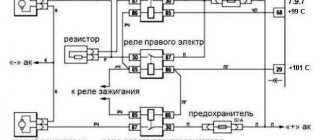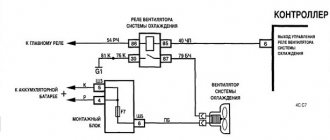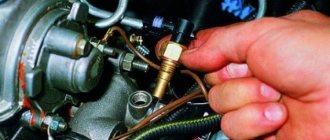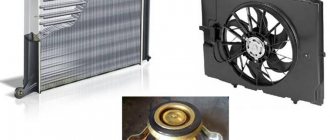All cars with an injection engine have an electric fan, not a mechanical one. With mechanics, everything was simpler... The fan motor is connected to the network through a relay, and the signal to this relay is supplied by the ECU . Additionally, there is a fuse in the motor circuit, and the antifreeze temperature sensor (ATS) is connected directly to the ECU. If the cooling fan does not work, you can do one trick on the VAZ-2114: turn off the DTOZh sensor and start the engine. And if the fan starts spinning, the problem must be looked for in the sensor.
To avoid having to examine the wiring inside and out, just watch one video. Everything here has already been done.
Cooling fan diagnostics - trying to find the problem
There will be two temperature sensors: one, which is on the thermostat, is connected to the ECU. It is necessary to turn it off - leave the second one as it is.
DTOZH on engine 11183
We disconnect the connector, but do not remove the sensor itself. Then we turn the key to position 1, and so on.
Electrically, things look complicated: the fan relay is in one box, and the fuse is in another. We need fuse F5 (20A). By the way, both a fan and a horn are connected to it.
Mounting block 2114-3722010-60 and 2114-3722010-10
The main mounting block is installed under the hood, and the additional one is located at the left foot of the front passenger.
Additional mounting block (option 1)
In the additional block we see three relays. The "main relay" is located at the bottom. And then there are possible options:
- The fan relay is mounted in the middle;
- This relay can also be installed at the top.
The second option is shown below.
Additional mounting block (option 2)
By the way, there is always a fuse located near the relay we need. It is part of the fan circuit.
Video example: simplification of the standard fan operation circuit (tuning)
well done, it’s better than electronics, the simpler the more reliable
I can bet I did everything as written in all the books and scoured the entire Internet but I can’t find the answer anywhere, I checked everything, everything works, all the relays work, the fan works, the sensor too. The minus has disappeared, although it fits all the relays, plus without breaking it I put the minus directly to the body and it works (even with the ignition off). I do not know what to do. So far I’ve done it, I’m driving straight ahead and waiting for tips...
Just click on the button and do it for 10 minutes until you get some money for the service)
The problem is in the ECU, apparently there is no minus from the microcircuit, and the TLE 6240 GP chip is responsible for it
Yesterday my cooling fan did not work in a traffic jam. VAZ 2115 produced in 2005 (Odessa). First of all, I tested to see if there was a signal. If there is a signal, then the fuse is intact (F5)), Then, with the ignition on, I pulled out the chip from the socket of the fan switch sensor (next to the thermostat) - the fan is silent. I checked the fan directly from the battery - lo and behold, it worked. And here one problem remains - two wires come out of the fan connection chip - one is white-black (minus), and the second is white-red (+). The first goes to the relay under the dashboard inside the cabin, the second, through a connector into the mounting block. After testing these wires, it turned out that there was no power from the mounting block (no + ). I had to remove and disassemble it. And the reason turned out to be a terminal in the mounting block that had fallen off due to overoxidation. After unsoldering the bad terminal and replacing it with a new one, everything worked. The work took about two hours and saved on the purchase of a new mounting block - that’s about 1,800 Khokhlobaks (hryvnia).
The fan does not work - we change it ourselves
Try to do this: you need to remove the negative terminal from the battery (the key is “10”), and then disconnect the motor connector.
Fan power connector
If you now connect the battery again, you can call “+12” on one of the two terminals. Now you can go all-in: the negative cord from the fan is connected to ground using a T-connector. Often on the VAZ-2114 hatchback the fan does not work because it is not the wiring that is faulty, but the motor. And then they perform the replacement.
Dismantling, all steps
Once again, make sure that you have disconnected the battery. Disconnect the connector as discussed above. Next, use a socket wrench to unscrew the two nuts holding the “stopper” (see photo).
Retaining bracket above the casing
There are four nuts at the corners of the plastic frame. They need to be unscrewed with a 10mm key.
One of four nuts
The mounting frame together with the fan is removed in the “up” direction. As you can see, everything is simple.
Installation of the unit is carried out in the reverse order. It will be possible to replace both the motor and the casing frame.
Articles
- 2108-1309010 – casing;
- 2109-1308008 (-01, -02) – motor assembled with impeller;
- 2103-1308010-10 – impeller;
- 12605571 – lock washer;
- 16102311 – M8 nut.
Purpose
The cooling fan is designed to cool the radiator with air, which it pumps with its impeller. Most often, the fan turns on in hot weather or when the car is stuck in a traffic jam, at these moments the fan is an indispensable part that keeps the engine from overheating.
What can happen to the engine if the cooling fan does not work:
- Due to severe overheating, the coolant may boil away and its level will drop significantly, which will reduce the engine cooling coefficient;
- Due to a significant increase in temperature, crankshaft liners and camshaft pastels, as well as valve seals, may be damaged;
- Possible occurrence of piston rings, both compression and oil scraper;
- Possible breakdown of the cylinder head gasket;
- Engine wedge;
As you can see, if the cooling fan does not work, this can lead to serious consequences, after which it will be necessary, if not a major, then a serious repair of the VAZ 2114 engine.
Conclusions: what exactly should be done if the fan does not work (action algorithm)
First, check whether the “plus” is connected to one of the terminals in the connector. Then connect the connector from ground to check the serviceability of the electric motor. In some cases, you can observe this:
- Both fuse F5 and the additional fuse are working;
- The fan relay operates as expected;
- The DTOZh sensor is working;
- The motor can only be turned on by applying a potential of “0 Volt”.
There will be only one conclusion: the ground contact has come loose, which ends the entire power line. This means you will need to contact an auto electrician. All other faults can be overcome by yourself.
Element F5 may burn out as a result of the horn closing. But then “+12” is not called up on the connector, which should immediately alert you.
Using an electromagnetic relay
Using a simple relay will slightly complicate the circuit, but will relieve the temperature sensor from the presence of high current. A large current will flow through the relay contacts. It is cheaper and easier to replace the relay than the temperature sensor to turn on the electric fan. To carry out the upgrade, you will need a wire and a relay with a bracket for mounting to the body.
Disconnect the temperature sensor, and the wires that were on it must be connected to the normally open pair of contacts of our relay. Half the job is done, the power part is ready. Now control. We connect one terminal of the temperature sensor to ground, but connect the second to the relay coil.
From the second terminal of the coil you need to stretch the wire to the positive terminal of the battery. It is advisable that the connection be made through a fuse, the operating current of which can be 1 Ampere. The coil consumes a small amount of current, so the worst thing that can happen is a short circuit in the wiring. Subsequently, you can connect a forced activation button in parallel with the temperature sensor, which you will install in the car interior.
Semiconductor Applications
Instead of an electromagnetic relay, you can use a thyristor switch, or a design based on field-effect transistors. The essence is the same, only there are no moving contacts; their functions are performed by electrons and holes in the semiconductor crystal. But do not forget about cooling thyristors and transistors; install radiators that will be able to provide the necessary heat transfer.
Soft engine start is a very useful function for engine control. This innovation will ensure a gradual increase in the load on the electric motor. This idea is accomplished by using PWM modulation. But along with all the innovations, you can use a second temperature sensor in the cooling system, whose response temperature is 5 degrees lower than the main one.
If, when the main sensor is triggered, the fan turns on at full power, then when the second sensor is triggered, its speed should be half as much. To do this, you will have to use a resistor when connecting. The one installed on the stove fan is perfect. This will prevent the temperature in the system from reaching extreme values.
The result is a more stable engine temperature. In addition, it warms up faster after starting and consumes less fuel. When the electric fan is turned on, it rotates quickly enough even at low engine speeds - and this reduces the risk of overheating under heavy loads in difficult road conditions. A mechanical fan is not always effective in such cases.
It would seem that the topic could be closed with a list of advantages, but the quality of electrical engineering does not allow it. Fan failure is a common thing, but the consequences can be impressive: having “boiled” the engine, an inexperienced driver often pays a lot of money for repairs. Some even deliberately abandoned the advanced system in favor of a reliable and simple belt drive.
What is the main reason for the vagaries of the electric fan? Its motor consumes current up to 15-20 A, turning on at the command of the coolant temperature sensor in the radiator (Fig. 1). To prevent large current from flowing directly through the delicate contacts of sensor 1, unloading relay 2 was used in the standard design. The solution is natural... but not perfect - on Russian cars, the temperature sensor has proven itself to be the most unreliable element in the cooling system. His contacts burn out - and that’s the end! And this, mind you, is provided that the unloading relay is working properly.
To explain the situation, you will have to remember what “self-induction” or “counter-induction” EMF is. Forgot? The Queen of Physics is neither cold nor hot from this - the phenomenon exists. And it works... Anyone who drives a car with a contact ignition system knows how badly refractory tungsten contacts burn, although they break a relatively small current with a voltage no higher than 14-14.5 V. It’s all about counter-induction: at the moment the contacts break the disappearing electromagnetic field not only creates a high voltage on the secondary winding of the ignition coil, necessary for the spark plug, but also a considerable, up to 400 V, counter-induction voltage in the primary winding. This is what “burns through” the contacts: each opening of them does not pass without leaving a trace - and over a thousand kilometers of travel, about 4 million of them accumulate. The result is contact erosion. The system is working worse and worse.
The contacts of the temperature sensor do not operate with such a high frequency, but they themselves are much weaker than the contacts of the breaker - the EMF of the counter-induction of the auxiliary relay coil eventually affects them - they burn out... And the more the temperature sensor has worked, the higher the probability of failure. When asking yourself the Shakespearean question “to boil or not to boil?”, the driver should often look at the temperature gauge and listen to the noise under the hood. But what’s even better is to replace the old sensor in time, so as not to take unnecessary risks. However, there are other possibilities.
